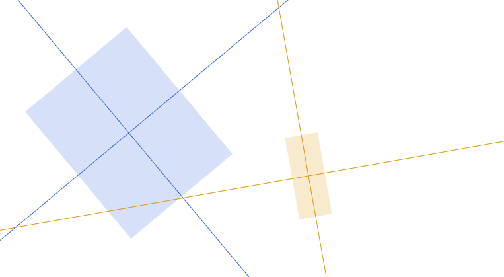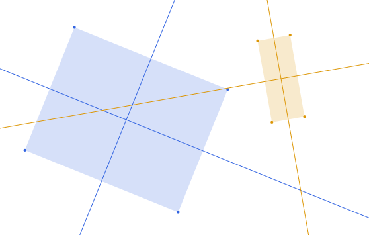I will use Javascript in order to demo this (and also provide code) but I can be done on every language following the process.
Links
Concept
In order to achieve this we'll use corners projections on the other rectangle 2 axis (X and Y).
The 2 rectangles are only colliding when the 4 projections on one rectangles hit the others:
- Rect Blue corners on Rect Orange X axis
- Rect Blue corners on Rect Orange Y axis
- Rect Orange corners on Rect Blue X axis
- Rect Orange corners on Rect Blue Y axis
![3 concept previews]()
Process
1- Find the rects axis
Start by creating 2 vectors for axis 0;0 (center of rect) to X (OX) and Y (OY) then rotate both of them in order to get aligned to rectangles axis.
Wikipedia about rotate a 2D vector
const getAxis = (rect) => {
const OX = new Vector({x:1, y:0});
const OY = new Vector({x:0, y:1});
// Do not forget to transform degree to radian
const RX = OX.Rotate(rect.angle * Math.PI / 180);
const RY = OY.Rotate(rect.angle * Math.PI / 180);
return [
new Line({...rect.center, dx: RX.x, dy: RX.y}),
new Line({...rect.center, dx: RY.x, dy: RY.y}),
];
}
Where Vector is a simple x,y object
class Vector {
constructor({x=0,y=0}={}) {
this.x = x;
this.y = y;
}
Rotate(theta) {
return new Vector({
x: this.x * Math.cos(theta) - this.y * Math.sin(theta),
y: this.x * Math.sin(theta) + this.y * Math.cos(theta),
});
}
}
And Line represent a slop using 2 vectors:
- origin: Vector for Start position
- direction: Vector for unit direction
class Line {
constructor({x=0,y=0, dx=0, dy=0}) {
this.origin = new Vector({x,y});
this.direction = new Vector({x:dx,y:dy});
}
}
Step Result
![enter image description here]()
2- Use Rect Axis to get corners
First we want extend our axis (we are 1px/unit size) in order to get the half of width (for X) and height (for Y) so by adding then (or inverse of them) we can get the all corners.
const getCorners = (rect) => {
const axis = getAxis(rect);
const RX = axis[0].direction.Multiply(rect.w/2);
const RY = axis[1].direction.Multiply(rect.h/2);
return [
rect.center.Add(RX).Add(RY),
rect.center.Add(RX).Add(RY.Multiply(-1)),
rect.center.Add(RX.Multiply(-1)).Add(RY.Multiply(-1)),
rect.center.Add(RX.Multiply(-1)).Add(RY),
]
}
Using this 2 news methods for Vector:
// Add(5)
// Add(Vector)
// Add({x, y})
Add(factor) {
const f = typeof factor === 'object'
? { x:0, y:0, ...factor}
: {x:factor, y:factor}
return new Vector({
x: this.x + f.x,
y: this.y + f.y,
})
}
// Multiply(5)
// Multiply(Vector)
// Multiply({x, y})
Multiply(factor) {
const f = typeof factor === 'object'
? { x:0, y:0, ...factor}
: {x:factor, y:factor}
return new Vector({
x: this.x * f.x,
y: this.y * f.y,
})
}
Step Result
![enter image description here]()
3- Get corners projections
For every corners of a rectangle, get the projection coord on both axis of the other rectangle.
Simply by adding this function to Vector class:
Project(line) {
let dotvalue = line.direction.x * (this.x - line.origin.x)
+ line.direction.y * (this.y - line.origin.y);
return new Vector({
x: line.origin.x + line.direction.x * dotvalue,
y: line.origin.y + line.direction.y * dotvalue,
})
}
(Special thank to Mbo for the solution to get projection.)
Step Result
![enter image description here]()
4- Select externals corners on projections
In order to sort (along the rect axis) all the projected point and take the externals projected points we can:
- Create a vector to represent: Rect Center to Projected corner
- Get the distance using the Vector Magnitude function.
get magnitude() {
return Math.sqrt(this.x * this.x + this.y * this.y);
}
- Use the dot product to know if the vector is facing the same direction of axis or inverse (when signed distance is negative)
getSignedDistance = (rect, line, corner) => {
const projected = corner.Project(line);
const CP = projected.Minus(rect.center);
// Sign: Same directon of axis : true.
const sign = (CP.x * line.direction.x) + (CP.y * line.direction.y) > 0;
const signedDistance = CP.magnitude * (sign ? 1 : -1);
}
Then using a simple loop and test of min/max we can find the 2 externals corners. The segment between them is the projection of one Rect on the other one axis.
Step result
![enter image description here]()
5- Final: Do all projections hit rect ?
Using simple 1D test along the axis we can know if they hit or not:
const isProjectionHit = (minSignedDistance < 0 && maxSignedDistance > 0
|| Math.abs(minSignedDistance) < rectHalfSize
|| Math.abs(maxSignedDistance) < rectHalfSize);
![enter image description here]()
Done
Testing all 4 projections will give you the final result. =] !!
![3 concept previews]()
Hope this answer will help as many people as possible. Any comments are appreciated.






